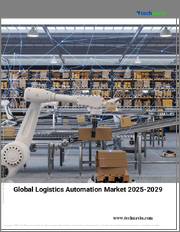
|
시장보고서
상품코드
1618207
물류 자동화 시장 기회, 성장 촉진요인, 산업 동향 분석 및 예측(2024-2032년)Logistics Automation Market Opportunity, Growth Drivers, Industry Trend Analysis, and Forecast 2024 - 2032 |
||||||
세계 물류 자동화 시장은 2023년 547억 달러로 평가되었고, 2024-2032년까지 연평균 12.3%의 성장률을 보일 것으로 예상됩니다. 이 같은 성장세는 주로 물류 자동화 기술에 빅데이터 분석이 통합되고 있기 때문으로 분석됩니다. 기업들은 빅데이터를 활용하여 다양한 소스에서 방대한 양의 정보를 수집하고 분석하여 의사결정 능력을 크게 향상시키고 있습니다. 또한 물류 및 공급망 관리에서 사물인터넷(IoT) 플랫폼의 채택은 시장 성장의 주요 촉진요인으로, IoT 장비는 재고, 배송 및 장비의 실시간 추적 및 모니터링을 용이하게 하여 전체 공급망에 대한 가시성을 크게 향상시킵니다.
이러한 상호 연결성을 통해 조직은 정보에 입각한 데이터 기반 의사결정을 내리고, 경로를 최적화하고, 자원을 효율적으로 관리할 수 있습니다. 또한, IoT 지원 센서는 유지보수 필요성을 예측하여 다운타임을 줄이고 전반적인 운영 효율성을 향상시킬 수 있습니다. 물류 자동화 시장은 구성 요소별로 하드웨어, 소프트웨어, 서비스로 구분되며, 2023년 하드웨어 부문이 전체 시장의 55% 이상을 차지하며 시장을 장악하고 2032년에는 850억 달러 이상에 달할 것으로 예상됩니다. 이 부문이 두드러지는 이유는 자동 보관 및 검색 시스템(AS/RS), 컨베이어 시스템, 로봇과 같은 효율적인 자재 취급 및 보관 작업에 필수적인 구성 요소들이 이 부문을 주도하고 있기 때문입니다.
시장은 또한 조직 규모에 따라 대기업과 중소기업(SME)으로 분류되며, 2023년에는 대기업이 시장 점유율의 약 64%를 차지할 것으로 예상됩니다. 대기업의 풍부한 자금력은 로봇 및 창고 관리 시스템을 포함한 첨단 자동화 기술에 대한 투자를 가능하게 합니다. 또한, 대기업은 복잡한 공급망을 가지고 있는 경우가 많으며, 자동화는 효율성, 정확성, 확장성을 크게 향상시킬 수 있기 때문에 경쟁 우위를 유지하는 데 필수적입니다.
| 시장 범위 | |
|---|---|
| 시작 연도 | 2023년 |
| 예측 연도 | 2024-2032년 |
| 시작 가격 | 547억 달러 |
| 예상 가격 | 1,484억 달러 |
| CAGR | 12.3% |
지역별로는 북미가 2023년 시장 점유율의 30% 이상을 차지할 것으로 예상되며, 2032년에는 500억 달러 이상에 달할 것으로 전망됩니다. 이 성장을 주도하는 국가는 미국으로, 같은 해에 450억 달러 이상에 달할 것으로 예상됩니다. 미국 물류 자동화 시장은 전자상거래의 급격한 성장과 업무 효율화에 대한 절박한 요구로 인해 수혜를 받고 있습니다. 소매업, 제조업, 의료 등 주요 부문에서는 업무 간소화와 비용 절감을 위해 로봇과 AI를 활용한 솔루션 등 자동화 기술 도입이 활발히 이루어지고 있습니다. 특히 팬데믹(세계적 대유행) 상황에서 공급망의 회복력을 중시하는 움직임은 조직들이 자동화를 통해 물류 역량을 강화하도록 장려하고 있으며, 미국을 세계 물류 자동화의 선두주자로 자리매김하고 있습니다.
목차
제1장 조사 방법과 조사 범위
제2장 주요 요약
제3장 산업 인사이트
- 생태계 분석
- 공급업체 상황
- 기술 제공업체
- 시스템 통합사업자
- 소프트웨어 개발 기업
- 부품 공급업체
- 컨설팅 회사
- 이익률 분석
- 물류 자동화 가격 분석
- 기술 및 혁신 전망
- 주요 뉴스 및 이니셔티브
- 규제 상황
- 영향요인
- 성장 촉진요인
- E-Commerce 플랫폼에 의한 채택 증가.
- 자동화 물류 기술 빅데이터 도입 증가
- 물류 공급망 관리 IoT 플랫폼 이용 증가
- 창고 관리 로봇 공학 높은 보급률
- 인원 삭감에 의한 비용 절감
- 산업의 잠재적 리스크와 과제
- 고액의 설비 투자 필요성
- 데이터 프라이버시에 관한 우려
- 성장 촉진요인
- 성장 가능성 분석
- Porter's Five Forces 분석
- PESTEL 분석
제4장 경쟁 구도
- 서론
- 기업 점유율 분석
- 경쟁 포지셔닝 매트릭스
- 전략 전망 매트릭스
제5장 시장 추정·예측 : 컴포넌트별, 2021-2032년
- 주요 동향
- 하드웨어
- 자동 보관·검색 시스템(AS/RS)
- 컨베이어 시스템
- 무인운반차(AG)
- 로봇
- 기타
- 소프트웨어
- 창고 관리 시스템(WMS)
- 운송 관리 시스템(TMS)
- 서비스
- 컨설팅
- 유지보수·지원
제6장 시장 추정·예측 : 조직 규모별, 2021-2032년
- 주요 동향
- 대기업
- 중소기업
제7장 용도별 시장 추정·예측 : 용도별, 2021-2032년
- 주요 동향
- 창고·보관 관리
- 운송 관리
제8장 시장 추정·예측 : 물류별, 2021-2032년
- 주요 동향
- 판매물류
- 생산물류
- 회수 물류
- 조달 물류
제9장 시장 추정·예측 : 최종 용도별, 2021-2032년
- 주요 동향
- 제조업
- 의료와 의약품
- 소비재
- 소매 및 E-Commerce
- 자동차
- 기타
제10장 시장 추정·예측 : 지역별, 2021-2032년
- 주요 동향
- 북미
- 미국
- 캐나다
- 유럽
- 영국
- 독일
- 프랑스
- 스페인
- 이탈리아
- 러시아
- 북유럽
- 아시아태평양
- 중국
- 인도
- 일본
- 한국
- 뉴질랜드
- 동남아시아
- 라틴아메리카
- 브라질
- 멕시코
- 아르헨티나
- 중동 및 아프리카
- 아랍에미리트(UAE)
- 남아프리카공화국
- 사우디아라비아
제11장 기업 개요
- Beumer Group
- Blue Yonder
- Daifuku
- Dematic
- GreyOrange
- Honeywell International Inc.
- IBM
- JR Automation
- Knapp AG
- Locus Robotics
- Murata Machinery Ltd.
- Oracle
- SAP
- Seegrid Corporation
- SSI Schaefer
- Swisslog Holding AG(Kuka Group)
- System Logistics
- TGW Logistics Group
- Toyota Material Handling
- Zebra Technologies
The Global Logistics Automation Market was valued at USD 54.7 billion in 2023 and is projected to expand at a compound annual growth rate (CAGR) of 12.3% from 2024 to 2032. This significant growth is primarily fueled by the increasing integration of big data analytics in logistics automation technologies. Companies are harnessing big data to gather and analyze vast amounts of information from diverse sources, which greatly enhances their decision-making capabilities. Additionally, the adoption of Internet of Things (IoT) platforms in logistics and supply chain management is a major driver of market growth. IoT devices facilitate real-time tracking and monitoring of inventory, shipments, and equipment, significantly improving visibility across the supply chain.
This interconnectedness allows organizations to make informed, data-driven decisions, optimize routes, and manage resources efficiently. Furthermore, IoT-enabled sensors can predict maintenance needs, reducing downtime and boosting overall operational efficiency. The logistics automation market is segmented by components into hardware, software, and services. In 2023, the hardware segment dominated the market, accounting for over 55% of the total share, and is expected to surpass USD 85 billion by 2032. This segment's prominence is attributed to essential components such as automated storage and retrieval systems (AS/RS), conveyor systems, and robotics, which are critical for efficient material handling and storage operations.
The market is also categorized based on organization size into large and small and medium-sized enterprises (SME). In 2023, large enterprises held around 64% of the market share. Their substantial financial resources allow them to invest in advanced automation technologies, including robotics and warehouse management systems. Additionally, large enterprises often have complex supply chains where automation can significantly enhance efficiency, accuracy, and scalability, thus making it essential for maintaining competitiveness.
| Market Scope | |
|---|---|
| Start Year | 2023 |
| Forecast Year | 2024-2032 |
| Start Value | $54.7 Billion |
| Forecast Value | $148.4 Billion |
| CAGR | 12.3% |
Regionally, North America accounted for over 30% of the market share in 2023 and is expected to exceed USD 50 billion by 2032, with the U.S. leading this growth, projected to surpass USD 45 billion by the same year. The U.S. logistics automation market is benefiting from the rapid growth of e-commerce and a pressing demand for operational efficiency. Key sectors such as retail, manufacturing, and healthcare are increasingly adopting automation technologies, including robotics and AI-driven solutions, to streamline their operations and reduce costs. Significant investments in technology and infrastructure are driving innovation within the market.Moreover, the emphasis on supply chain resilience, particularly during the pandemic, encourages organizations to enhance their logistics capabilities through automation, positioning the U.S. as a frontrunner in the global logistics automation landscape.
Table of Contents
Chapter 1 Methodology & Scope
- 1.1 Research design
- 1.1.1 Research approach
- 1.1.2 Data collection methods
- 1.2 Base estimates and calculations
- 1.2.1 Base year calculation
- 1.2.2 Key trends for market estimates
- 1.3 Forecast model
- 1.4 Primary research & validation
- 1.4.1 Primary sources
- 1.4.2 Data mining sources
- 1.5 Market definitions
Chapter 2 Executive Summary
- 2.1 Industry 360° synopsis, 2021 - 2032
Chapter 3 Industry Insights
- 3.1 Industry ecosystem analysis
- 3.2 Supplier landscape
- 3.2.1 Technology providers
- 3.2.2 System integrators
- 3.2.3 Software developers
- 3.2.4 Component suppliers
- 3.2.5 Consulting firms
- 3.3 Profit margin analysis
- 3.4 Pricing analysis in logistics automation
- 3.5 Technology & innovation landscape
- 3.6 Key news & initiatives
- 3.7 Regulatory landscape
- 3.8 Impact forces
- 3.8.1 Growth drivers
- 3.8.1.1 Increased adoption by the e-commerce platforms
- 3.8.1.2 Rising adoption of big data in automated logistics technologies
- 3.8.1.3 Increasing use of IoT platform in logistics and supply chain management
- 3.8.1.4 The high penetration of robotics in warehouse management
- 3.8.1.5 Reduced cost due to decreasing need for manpower
- 3.8.2 Industry pitfalls & challenges
- 3.8.2.1 Requirement of high capital investment
- 3.8.2.2 Data privacy concerns
- 3.8.1 Growth drivers
- 3.9 Growth potential analysis
- 3.10 Porter's analysis
- 3.11 PESTEL analysis
Chapter 4 Competitive Landscape, 2023
- 4.1 Introduction
- 4.2 Company market share analysis
- 4.3 Competitive positioning matrix
- 4.4 Strategic outlook matrix
Chapter 5 Market Estimates & Forecast, By Component, 2021 - 2032 ($Bn)
- 5.1 Key trends
- 5.2 Hardware
- 5.2.1 Automated Storage and Retrieval System (AS/RS)
- 5.2.2 Conveyor system
- 5.2.3 Automated Guided Vehicles (AG)
- 5.2.4 Robotics
- 5.2.5 Others
- 5.3 Software
- 5.3.1 Warehouse Management System (WMS)
- 5.3.2 Transportation Management System (TMS)
- 5.4 Services
- 5.4.1 Consulting
- 5.4.2 Maintenance and support
Chapter 6 Market Estimates & Forecast, By Organization Size, 2021 - 2032 ($Bn)
- 6.1 Key trends
- 6.2 Large enterprises
- 6.3 SME
Chapter 7 Market Estimates & Forecast, By Application, 2021 - 2032 ($Bn)
- 7.1 Key trends
- 7.2 Warehouse and storage management
- 7.3 Transportation management
Chapter 8 Market Estimates & Forecast, By Logistics, 2021 - 2032 ($Bn)
- 8.1 Key trends
- 8.2 Sales logistics
- 8.3 Production logistics
- 8.4 Recovery logistics
- 8.5 Procurement logistics
Chapter 9 Market Estimates & Forecast, By End Use, 2021 - 2032 ($Bn)
- 9.1 Key trends
- 9.2 Manufacturing
- 9.3 Healthcare and pharmaceuticals
- 9.4 Fast-moving consumer goods
- 9.5 Retail and e-commerce
- 9.6 Automotive
- 9.7 Others
Chapter 10 Market Estimates & Forecast, By Region, 2021 - 2032 ($Bn)
- 10.1 Key trends
- 10.2 North America
- 10.2.1 U.S.
- 10.2.2 Canada
- 10.3 Europe
- 10.3.1 UK
- 10.3.2 Germany
- 10.3.3 France
- 10.3.4 Spain
- 10.3.5 Italy
- 10.3.6 Russia
- 10.3.7 Nordics
- 10.4 Asia Pacific
- 10.4.1 China
- 10.4.2 India
- 10.4.3 Japan
- 10.4.4 South Korea
- 10.4.5 ANZ
- 10.4.6 Southeast Asia
- 10.5 Latin America
- 10.5.1 Brazil
- 10.5.2 Mexico
- 10.5.3 Argentina
- 10.6 MEA
- 10.6.1 UAE
- 10.6.2 South Africa
- 10.6.3 Saudi Arabia
Chapter 11 Company Profiles
- 11.1 Beumer Group
- 11.2 Blue Yonder
- 11.3 Daifuku
- 11.4 Dematic
- 11.5 GreyOrange
- 11.6 Honeywell International Inc.
- 11.7 IBM
- 11.8 JR Automation
- 11.9 Knapp AG
- 11.10 Locus Robotics
- 11.11 Murata Machinery Ltd.
- 11.12 Oracle
- 11.13 SAP
- 11.14 Seegrid Corporation
- 11.15 SSI Schaefer
- 11.16 Swisslog Holding AG (Kuka Group)
- 11.17 System Logistics
- 11.18 TGW Logistics Group
- 11.19 Toyota Material Handling
- 11.20 Zebra Technologies



















